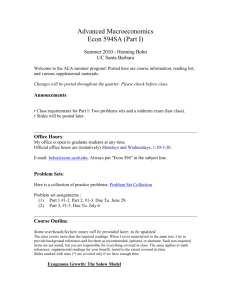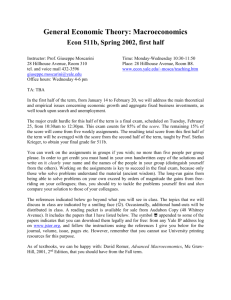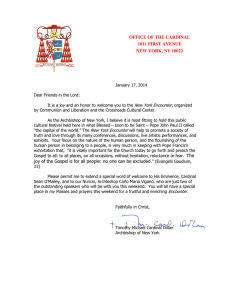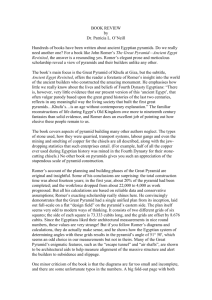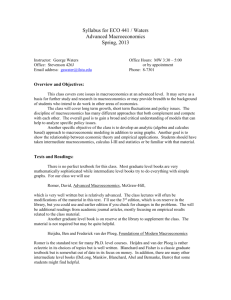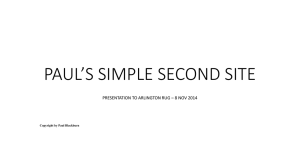On Measuring Knowledge in New (Endogenous) Growth Theory Ian
advertisement
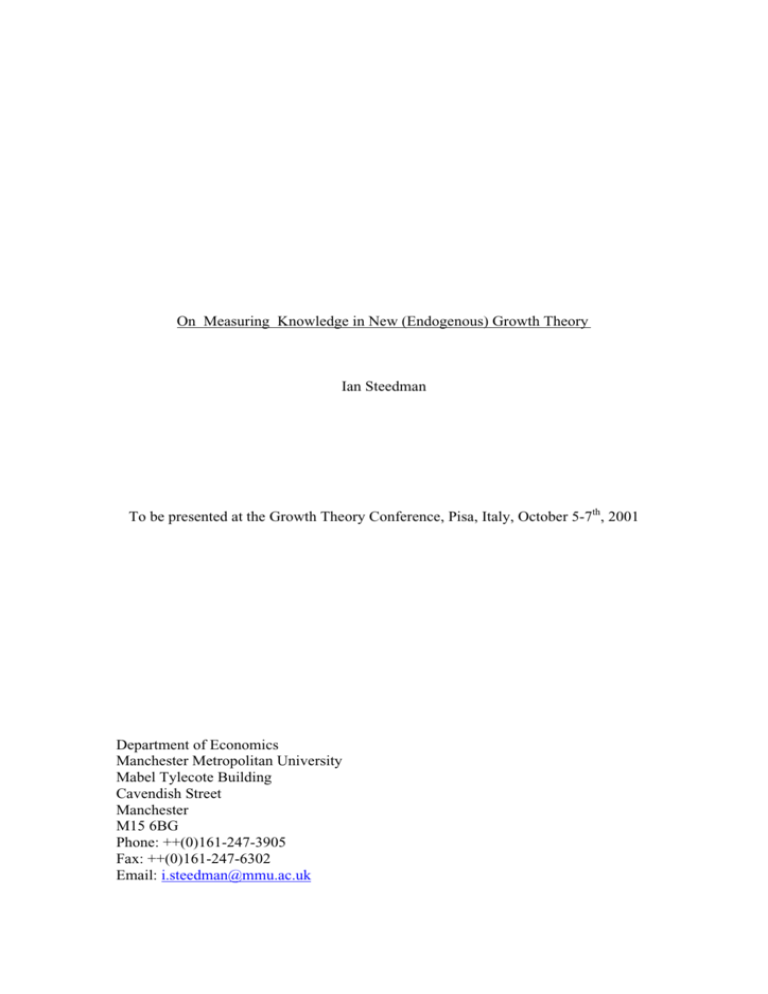
On Measuring Knowledge in New (Endogenous) Growth Theory Ian Steedman To be presented at the Growth Theory Conference, Pisa, Italy, October 5-7th, 2001 Department of Economics Manchester Metropolitan University Mabel Tylecote Building Cavendish Street Manchester M15 6BG Phone: ++(0)161-247-3905 Fax: ++(0)161-247-6302 Email: i.steedman@mmu.ac.uk On Measuring Knowledge in New (Endogenous) Growth Theory Ian Steedman Introduction In all too many contributions to New (Endogenous) Growth Theory — though not in all — central reference is made to a stock of knowledge , a stock of ideas , etc., this variable featuring centre-stage in the analysis. Yet it is immediately apparent that this is far from being a crystal clear concept. Is knowledge a homogeneous quantity of which there is simply more or less? Clearly not. How then, in constructing a measure of the total stock, is one to select the weights (prices) with which an idea in carbon chemistry, say, is to be combined with an idea in the production of insurance services. It is not obvious what the weights are, and they certainly are not to be found in market prices . (Metcalfe, 2001, p.580) One may also wonder to what extent knowledge is truly non-rivalrous, as opposed to being specific to sets of individuals (Metcalfe, 2001, p.569) and, to the extent that knowledge is held in common, whether one ought not to think of the total stock as being the union rather than the sum of individual stocks . (Olsson, 2001, pp. 10-11) Even if knowledge either is or can be rendered homogeneous — and that is a very big if — the question arises whether there exists anycardinal measure of the single stock of knowledge. It is certainly — and lamentably — common in the NGT literature to treat the stock of knowledge as if it were a single magnitude with a cardinal measure, without any justification being given for this highly dubious assumption. 2 Cardinality Few if any authors indeed state explicitly and openly that they suppose the stock of knowledge to be cardinally measurable. Yet they repeatedly assert this by implication. Let A represent the stock of knowledge. We read over and over again that a function with A as one of its arguments does (or does not) exhibit constant returns to scale. But either assertion is utterly meaningless word-juggling if A is measurable only ordinally! Again, we read over and over again that, in such a function, A has a decreasing (or increasing) marginal product — i.e., that equal successive increments in A yield decreasing (or increasing) increments in output. By the very meaning of ordinality, however, no meaning can be attached to the claim that successive increments in (ordinal) A are (or are not) equal! Yet again, the relevant literature frequently presents equations in which (dA/dt) is set equal to some power of A multiplied by other variables. These equations too are meaningless unless A is cardinally measurable. And yet they are never supported by any indication of how such a cardinal measure may be found or constructed. This is certainly not measurement without theory ; it is theory without the minimal conceptual clarity required to make that theory worthy of attention. No amount of sophisticated mathematical analysis can turn conceptual confusions into meaningful conclusions. 3 Selected quotations from the literature We should now perhaps establish that our critical remarks are not directed to a pure figment of our imagination — and recognize that worries about the measurement of knowledge can indeed be found within the NGT literature. The following examples are far from being exhaustive, of course, and it is not implied that every NGT model involves the kind of difficulty we are considering. Our examples are presented in historical order — which will make it clear that there has not been clear cut progress in conceptual clarity about measuring knowledge! In his famous learning-by-doing paper (1962), Arrow painted a pi cture of technical change as a vast and prolonged process of learning about the environment in which we operate . (p.155) He went straight on, however, to refer to a variable so difficult to measure as the quantity of knowledge . (ibidem) Sensibly, therefore, Arrow did not make any amount of knowledge a central variable in his analysis but used, rather, cumulative gross investment- a measurable variable taken to be positively related to the acquisition of knowledge. Not everyone, alas, has followed Arrow s excellent (and very early) lead. Romer (1986) begins his formal analysis with a two-period model in which production of consumption goods in period 2 is a function of the state of knowledge, denoted by k, and a set of additional factors denoted by a vector x . (p.1014) This knowledge is produced from forgone consumption in period 1 . (p.1015) We then read that output in firm i is given by F(ki , Σk j, x i), where F( ) is assumed to be concave in ki, and that, Without this assumption, a competitive equilibrium will not exist in general . (p.1015) But this crucial assumption involves a purely meaningless assertion (re concavity) unless the state of knowledge , ki, is a cardinally measurable 4 variable! And just what might be the cardinal measure of the state of knowledge ? or of knowledge? Romer gives us no indication. Nothing daunted, he assures us that the production function exhibits global increasing marginal productivity of knowledge from a social point of view (p.1015) Talk of increasing (or decreasing, or constant) marginal productivity is, of course, empty hot air unless the knowledge variable has a cardinal measure. Exactly comparable issues arise as Romer goes on to develop a continuous time, infinite horizon analysis (p.1019 ff) but we may conclude here by noting his later reference to a model in which knowledge and capital are used in fixed proportions (pp.1034-5); what could that reference possibly mean unless both knowledge and capital have cardinal measures? In his 1988 contribution Lucas reasons in terms of human capital rather than knowledge and, as is well known, these two variables can be significantly different with respect to both rivalry and excludability. It may nevertheless be useful here to note some of his remarks relating to cardinality and measurability. Thus Lucas writes (p.17): By an individual s human capital I will mean … simply his general skill level, so that a worker with human capital h(t) is the productive equivalent of two workers with _h(t) each, or a half-time worker with 2h(t) . What, one may wonder, is the cardinal measure of general skill level that renders possible Lucas s statements about productive equivalence? His formal analysis certainly depends on the existence of such a measure, since his equation (13) (on p.19) h& (t) = h(t) [1 − u(t) ] would be meaningless without it. 5 We do not suggest that Lucas is unaware of the measurement problem, however. To the contrary, he observes that we can no more directly measure the amount of human capital a society has, or the rate at which it is growing, than we can measure the degree to which a society is imbued with the Protestant ethic . (p.35) After referring to human capital as a force, admittedly unobservable (ibidem ), he goes on to suggest that, Physical capital, too, is best viewed as a force, not directly observable, that we postulate in order to account in a unified way for certain things we can observe. (p.36) Even if we are prepared to admit these mysterious forces a place in formal economic analysis — a big if , perhaps — we may still be unconvinced that they can be represented in that analysis by cardinal measures exhibiting constantreturns-to-scale, diminishing/increasing marginal products, etc.. Analogously, it is one thing to say that (exogenously or endogenously) increasing knowledge is important to economic growth; it is quite another to include it in references to returns-to-scale, variable marginal products, etc. Romer s (1990) paper makes little advance over (1986) with respect to the issues at hand. At first we find a rather abstract discussion (p.S76) of the relations F(λA, λX) > λ F(A,X) and F(A, X) < A ∂F ∂F +X ∂A ∂X where A represents non-rival inputs and X rival inputs. But Romer then refers to Arrow (1962) as assuming that an increase in K necessarily leads to an equiproportionate increase in knowledge [does Arrow actually say this?] and by (p.S77) we are reading of non-rival knowledge and of A as the benefits of reseach 6 and development . Are knowledge and the benefits of R & D synonymous expressions? Either way, are there cardinal measures of these magnitudes? In his ⁄III, Romer explains that, The four basic inputs in this model are capital, labor, human capital, and an index of the level of technology . (pp.S78-S79) Just how can an index of the level of technology be an input to a productive process? Does it not matter at all how language is used in economic theorizing? Be that as it may, it is noteworthy that Romer makes fairly clear remarks on how to measure the first two inputs , some vaguer remarks on measuring the third input — and says nothing whatever on how to measure the fourth! Romer presses on. The existing stock of knowledge is an input in the research sector (p.S79); is the stock of knowledge the same thing as the index of the level of technology ? Can a stock be an index ? If they are not the same thing, how are they related? In any case, the product of the research sector is designs for new producer durables (p.S79) or, by the next page, new designs or knowledge (p.S80). Romer produces new terms (for the same thing?) at an impressive rate! At this stage in Romer s analysis A becomes an integer; but he is not really claiming to have produced a cardinal measure of the level of technology/knowledge/designs, of course. The integer nature of A is a mere artefact. Subsequently, in equation (3) of (p.S83) & = H A A A where HA is human capital in research and A is the total stock of designs and knowledge . (Note — the stock of designs and knowledge now!) This equation is meaningless unless there are cardinal measures for both HA and A. 7 In their discussion of Models with Learning-by-Doing and Knowledge Spillovers , Barro and Sala-i-Martin (1995) consider a production function for firm i Yi = F (Ki, AiLi) where L i and Ki are the conventional inputs, and Ai is the index of knowledge available to the firm . (p.146; by p.147, Ai has become the firm s stock of knowledge !) We are told that a steady state exists when A i grows at a constant rate . (p.146) And what can that mean when Ai is an index or a stock of knowledge ? Nothing; unless Ai has a cardinal measure and — surprise, surprise — we are told nothing of how such a measure may be found or constructed. A new element of terminological slapdashery (not of terminological progress) is to be found in Jones (1995). Describing what he calls the Romer/GrossmanHelpman/Aghion-Howitt models , Jones sets out the equations Y = K1-α (ALy)α and & /A = δ L A A where A is productivity or knowledge . (p.761) Productivity or knowledge!? (Matters would be little improved if this is a misprint for productivity of knowledge. ) By p.765 (and Fig.5, p.776), however, A is the level of knowledge but, & /A) is a as usual, we are given no advice on how this can be measured so that (A meaningful magnitude. Or so that one can give meaning to Jones s equation (6) which, in equilibrium, becomes (p.765) & = L A A A 8 How valuable is the careful analysis of equations the variables in which are of unclear meaning? A ray of hope in the general gloom of carelessness and casualness has been provided recently by Aghion and Howitt, who offer a 14 page appendix On Some Problems in Measuring Knowledge-Based Growth. (1998, pp.435-448; fourteen pages, that is, in a volume of 694 pages.) They note immediately that we do not have any generally accepted empirical measures of such key theoretical concepts as the stock of technological knowledge, human capital the rate of obsolescence of old knowledge, and so forth. (p.435) And they make it perfectly clear that the problem is not a purely empirical or data problem: It would be more accurate to say that formal theory is ahead of conceptual clarity. As the English side of the Cambridge capital controversy used to insist, the real question is one of meaning, not measurement. Only when theory produces clear conceptual categories will it be possible to measure them accurately . (ibidem) Aghion and Howitt do not pretend to have resolved all the relevant issues — far from it — but they do identify the problem at hand and begin to think it through. (It is to be hoped that their attempt attracts more attention than did Arrow s clear (1962) warning!) They conclude: If the critical component of our discussion in this appendix has been larger than the constructive component, this is mainly attributable to the fact that what is at issue is not something likely to be fixed by minor tinkering with national income accounting practices a better conceptual foundation is needed before we know just what magnitudes to look at and how. (p.447) These warnings seem to have come too late for Jones (1999), however. Surveying The Romer/Grossman-Helpman/Aghion-Howitt Models he writes (p.140) 9 Y = A LY and & /A = L A A where A is the stock of ideas . (These equations are also said (p.141) to reappear in The Young/Peretto/Aghion-Howitt/Dinopoulos-Thompson Models with a variable number of products.) And with respect to The Jones/Kortum/Segerstom Model he states (p.140) that the second equation is replaced by & = L A A A where φ < 1 may be positive or negative. Nowhere is it even mentioned that these equations have no meaning if there is not a cardinal measure of the stock of ideas ! And this nearly 40 years after Arrow (1962) sounded a clear, explicit warning. Concluding remarks A depressingly significant proportion of the NGT literature just ploughs ahead into the analysis of un-thought-out assumptions, offering for example (non-) constant-returns and variable marginal products with respect to variables one of which — the stock of knowledge — has not been shown to be, and may well not be, cardinally measurable. Such a cavalier approach does the profession little credit, for conceptual confusions cannot yield convincing conclusions. References Aghion, P. and Howitt, P. (1998) Endogenous Growth Theory. Cambridge, Mass. and London, MIT Press. Arrow, K.J. (1962). The economic implications of learning-by-doing. Review of Economic Studies, 29(1),pp.155-173. Barro, R.J. and Sala-i-Martin, X. (1995) Economic Growth. New York, McGraw-Hill. 10 Jones, C.I. (1995) R & D-based models of economic growth. Journal of Political Economy, 103,pp.759-784. Jones, C.I. (1999) Growth: with or without scale effects? American Economic Papers (Papers & Proceedings), May, pp.139-144. Lucas, R.E. (1988) On the mechanics of economic development. Journal of Monetary Economics, 22, pp.3-42. Metcalfe, J.S. (2001) Institutions and progress. Industrial and Corporate Change, 10(3),pp.561-585. Olsson, O. (2001) The appearance of knowledge in growth theory. Economic Issues, 6(1), pp.1-20. Romer, P.M. (1986) Increasing returns and long-run growth. Journal of Political Economy, 94, pp.1002-1037. Romer, P.M. (1990) Endogenous technical change. Journal of Political Economy, 98, pp.S71-S102. H:\Steedman\2001\pisa paper 11

